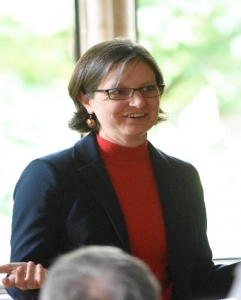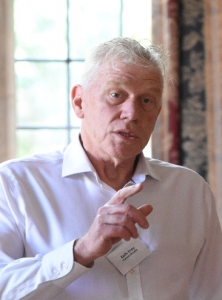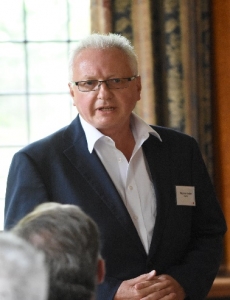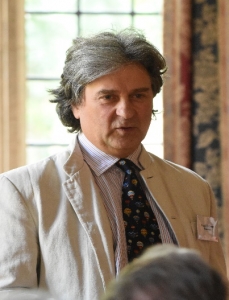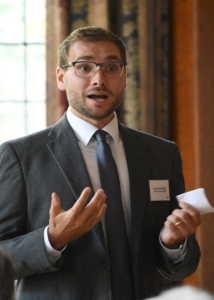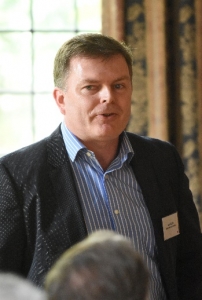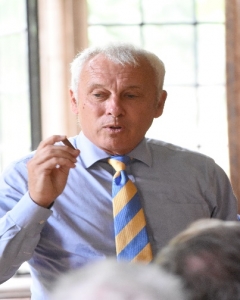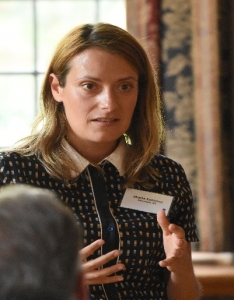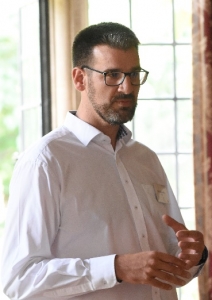Rhodes House, July 4th 2018.
The dinner took place in the vast timber-framed hall at Rhodes House, an echo of England’s Imperial past with Oxford whimsicality added. The theme of Space was an interesting one to consider in such a ‘spacious’ environment. The Oxford area encompassing Culham and Harwell is a leader in the emerging field of ‘New space’ and the leading centre for ‘dramatic’ engineering, such as fusion power and rocket technology. Our principal speaker, Lord Willetts, is a political ‘Space Leader’, due to his earlier role in government supporting the sector and his continuing engagement since.
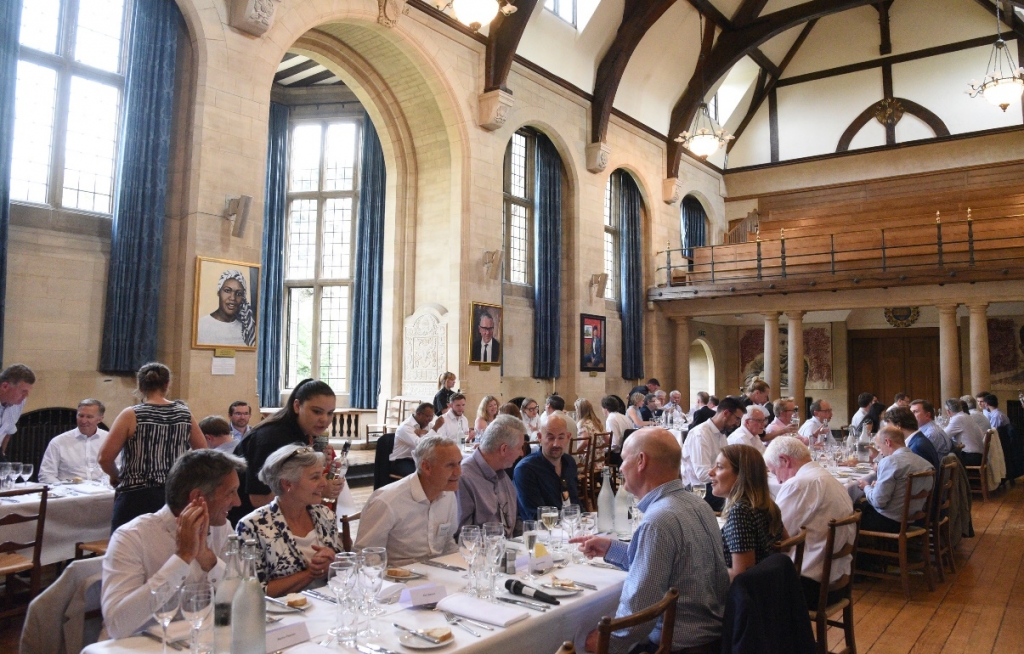
Dinner Guests, viewed from Top Table
Speakers
Rt Hon Lord David Willetts: Chairman of the Resolution Foundation and the Eight Great Technologies Fund; former Minister for Science and Universities.
Richard Varvill: Co-founder of Reaction Engines Ltd; most disruptive of rocket engines.
Rob Spurrett: Founder and CEO of Lacuna Space Ltd; leading New space venture entrepreneur.
Self-Intro Session
Each Bessemer Dinner has a 2-minute self-intro session for selected members and guests.
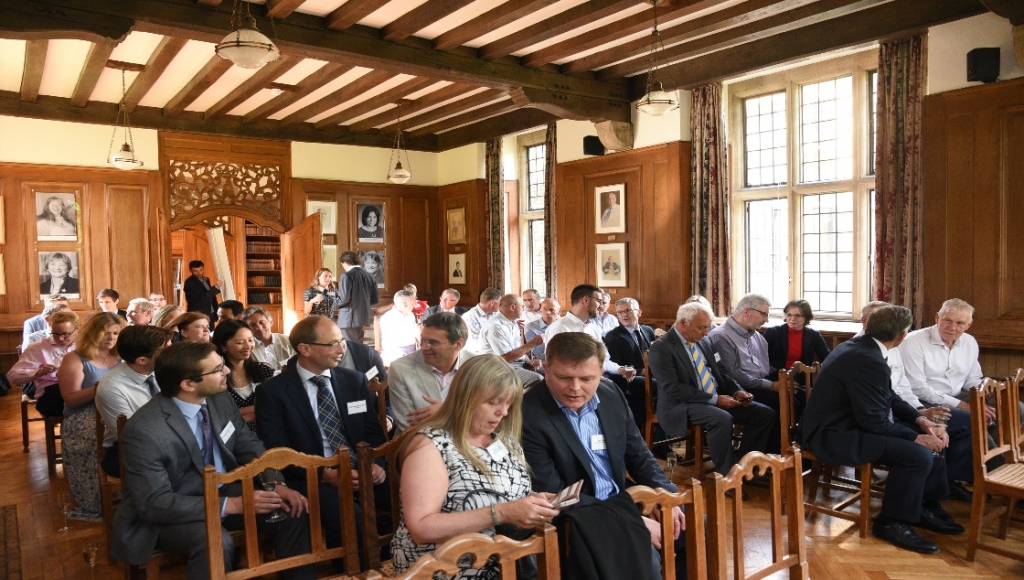
Settling down for the Self-Intros
Chris Elsworthy, Founder and CEO of CEL Ltd develops and manufactures 3D printers in Bristol; they are commercialising a method to automate the labour-intensive wire harnessing process in manufacturing.
Stephen Voller, Founder and CEO of ZapGo Ltd, based on the Harwell Campus, is preparing to launch a super-fast battery charger based on carbon nanomaterials and graphene.
Keith Errey, Serial entrepreneur and co-founder of Isansys Lifecare makes wireless patient monitoring systems. Keith is a founding member of the Bessemer Society, based in Oxford.
Adina Gillespie is strategist at Earth-i, a hi-res image data communications company; previously at Surrey Satellite Systems.
Hugo Spowers is the founder and CEO of Riversimple, a hydrogen fuel cell eco car company with a disruptive business model.
John Yates, MD of Helix Technologies Ltd – the designer and manufacturer of GNSS antennas for applications such as M2M, IoT, driverless cars and drone-delivery systems.
Ian Cash, founder of International Electric Company Ltd which holds patents for a novel microwave phased array antenna suitable for space applications and wireless power transfer.
Andre Nemeth at Oxmet Technologies leads the programme to develop and process new nickel alloys for additive manufacture. Oxmet span out of Oxford University in 2017.
Speaker Gallery
- Adina Gillespie
- Keith Errey
- Stephen Voller
- Hugo Spowers
- Andre Nemeth
- Ian Cash
- John Yates
- Maria Kalama, Innovate UK
- Rob Elsworthy
SPEAKERS
Rob Spurrett, Lacuna Space Ltd

Rob Spurrett, Lacuna Space Ltd
What is happening in the Oxford Space industry
Rob is a serial space entrepreneur, who besides his leadership role at Lacuna Space is the Chair of Harwell-based, Oxford Space Systems Ltd, one of the bright lights among New space companies in Europe. He is also a founder of Cherry Space, which invests in the Space sector. Earlier he worked at Rolls-Royce, and at one point worked on what has become Reaction Engine’s SABRE engine. Despite this, neither Richard Varvill nor Rob had met before, so the Bessemer Dinner proved a good connector.
Space Promoter
As an enthusiastic Space promoter, Rob told us the industry employs 40,000 people and generates £14bn of turnover, but in spite of this its importance is not well understood: it should go out and blow its trumpet more! The controversy about whether the UK can remain a part of the Galileo global navigation satellite system (GNSS) was a reminder of the important contribution the UK space industry had made to it and the potential loss to the UK (and Europe) if excluded.
Significance of New Space
New space changes the economics and dynamics of the space industry, he explained. In the old space industry, the approach to large scale satellite development is linear and highly time-consuming, requiring detailed engineering and a very lengthy Test, Prove and Build process. In the New space industry, micro satellites are cheap enough to be launched by a university; this has “democratised access to space”.
F1 Mentality
The New space industry operates in disruptive leaps and bounds, not unlike Formula-1, especially in the earlier years of F-1, before the huge amounts of money invested in race teams made it more cautious. Micro satellites are upgraded and replaced much more frequently than large satellites, and so new technology development is continuous with no gaps between launches. The mentality required therefore suits the UK’s strengths in F-1.
Major Elements
Rob noted three elements that underpin the nature of the New space industry:
1) Constant innovation: New space operates “within the laws of physics” rather than tries to “break” its laws – which requires huge budgets to do.
2) Collaborative: The Oxford Cluster facilitates collaboration. Oxford Space Systems for example has benefited from a collaboration with a professor at the University who is a world leader in Origami Engineering. This made it possible to develop an antenna that can deploy to a 5m wingspan from a micro satellite the size of a toaster!
3) Private investment: New space is funded mainly by private investors; Lacuna Space for example is establishing a satellite launch facility solely funded by private investors. The sector received £70mil of private investment last year: investment was expected to reach £280mil after four years but he expects it will reach it in half that time.

Micro Satellite Constellations: a picture of New Space through Space X’s eyes.
Richard Varvill – Reaction Engines Ltd
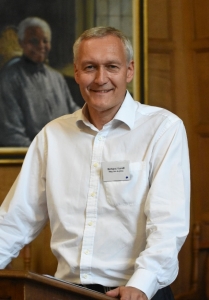
Richard Varvill – Reaction Engines Ltd
A revolution in jet propulsion – now to bring it to market
Richard is a co-founder and technical director of Reaction Engines Ltd, based at Culham Laboratories, next door to Harwell.
The story of Reaction Engines’ development work, from the ‘Skylon’ rocket to the SABRE engine, is ambitious in the extreme. It was therefore a special treat to have Richard tell us about it, and to do so in the presence of David Willetts, who in government had been a strong advocate of the company’s funding needs.
The Early Days
It was while the founders were at Rolls-Royce in the 1980s that they conceived the design of an ‘air breathing’ rocket engine. Initially the audacious idea received funding from Government and Rolls-Royce, but after two years the funding from R-R ceased, even though as Richard told us, “Concorde was increasing the cost of air travel, while HOTOL [as the early variant of the rocket was called], was going to reduce the cost of space travel”.
Never give up!
But rather than give up Richard persuaded Alan Bond, the key inventor, to go independent. They expected a rush of companies eager to pay for the technology, but instead, “We jumped into the pool and found it was empty!” They had to continue the development and find the investment alone. What motivates them is how Space offers a limitless source of mineral to meet the earth’s dwindling supplies, and it provides a permanent source of power from the sun.
Challenge
The problem though is that access to space is very expensive – between $100mil and $200mil for a single launch. Fuel burn is a major factor. Taking air from the atmosphere can reduce the amount consumed to 1/5th. The key technology they have developed to do this is a method to remove the build-up of heat from the over-heated engine.
Boot strapping
They started with two Amstrads with floppy disk drives and a fax machine. “Never underestimate what an engineer can achieve with limited resources”, quipped Richard. But when it came to spending real money, they found City wallets closed. Funding from government and companies like Rolls-Royce did not materialise until they had demonstrated the pre-cooler technology, in 2012. Since then the government has granted £60mil towards the development of its ‘Synergetic Air Breathing Rocket Engine’ (SABRE) for propelling both high speed aircraft and spacecraft.
Funding
Reaction Engines operates today with 200 employees, and a test site on an airfield, meaning cash burn is high. An industry veteran from Rolls-Royce was hired as CEO in 2015; and further appointments from industry have since been made. Recently £20mil was raised from a consortium, including existing investor, BAE, and two new investors, Rolls-Royce and Boeing’s venture capital arm, HorizonX.
Silicon Valley?
One could imagine it would be easier if the company was located in Silicon Valley, the home of Space X, but that would negate the aim of government to exploit the fruits of UK research in the UK. The UK defence and aerospace sector is big enough to nurture Reaction Engine’s technology, but seems unwilling without government support. The next best thing therefore would be if Silicon Valley money came to the UK to invest instead.
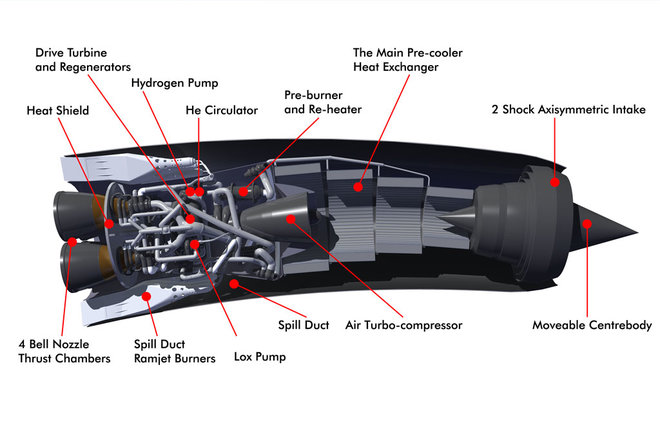
Diagram of the reusable SABRE engine, which employs a revolutionary heat exchanger to chill incoming air dramatically before it is fed to the engines.
David Willetts – the Politician of Space
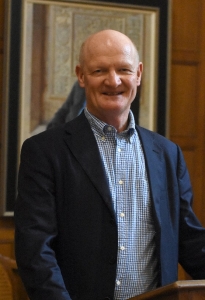
David Willetts – the Politician of Space
I am being slightly tongue in cheek to call David Willetts, the ‘Politican of Space’, especially as he is not any longer a politician! However, when he was the Minister for Universities and Science in the Coalition government, he was a great enthusiast for Space, where his responsibilities covered Harwell, Culham, and the emerging New space sector; as mentioned above he also championed Reaction Engines. His interest in the sector continues: only the month before the dinner he opened a new space laboratory on the Harwell Campus; he is also the chairman of the Eight Great Technologies Fund, which features Space among its 8 Greats.
Below is a comment David sent after the dinner:
“I am a great admirer of what you do at the Bessemer Society. It stands for exactly the kind of technology-based innovative enterprises I want to back when the Eight Great Technology fund is up and running.”
New Space
Introducing David before his talk, Bessemer’s chair, Michael LeGoff, provided his own context for why New space is an essential platform provider. At Plessey Semiconductors, the company which he founded, they are developing microLEDs for VR and mixed reality applications, “a huge new market”. The data these applications run will depend on satellite and satellite-related services for their delivery. New space is an essential component therefore of this new sector.
I’m an optimist
David opened his talk by explaining, “I’m an optimist”. This results from the paradox that the absence of government support for ‘Old space’ helped to prepare the ground for the take up of opportunities in New space. Before 2010 successive governments largely ignored the Space sector leaving it to the scientific elites of Europe (e.g. France) and the USA. Consequently, it did not absorb thousands of UK engineers, and left the UK more “nimble footed” to take up opportunities offered by New space. “It allowed us to be the Hitch Hikers of the Galaxy” as David put it. Surrey Satellite Systems, founded by Prof Sweeting at Surrey University, for example, was the first to commercialise micro satellites. Afterwards came Cube Sats, pioneered at Stanford University. The emergence of these new Space platforms required totally different skills and ways of thinking, which suited the UK’s strengths in digital technology (satellite services) and bootstrap innovation.
Entrepreneurial mentality
Another advantage in the absence of government support was to encourage an entrepreneurial mentality: companies like Reaction Engines had to bootstrap, painfully; and entrepreneurs like David Williams, the founder of Avanti Communications, went out and established new ‘hitch hiking’ satellite services without public money. David called this an “accident of history” which turned out to benefit the UK.
Turning point
The attitude towards the emerging field of New space changed in 2010 when the Minister for Science and Innovation in the Labour government, Lord Drayson, a businessman and entrepreneur, introduced a “Space Innovation and Growth Strategy”, one result of which was the establishment of the UK Space Agency. David Willetts continued this work when the Coalition government came to power and established a Space Leadership Council to advise the new Space Agency.
Space Port
There is much more to do, said David. The providers of satellite services continue to drive demand for new space platforms, launch options, and service packages. The next announcement he told us would be the establishment of a Space Port in the north of Scotland (announced shortly after the dinner) on an abandonned RAF base.
ESA
Brexit had thrown up fresh challenges, such as the threat to remove the UK from the Galileo Programme. However, the European Space Agency fell outside the EU’s direct control and the UK would therefore remain a part of it irrespectively. At least here Space was bigger than politics.
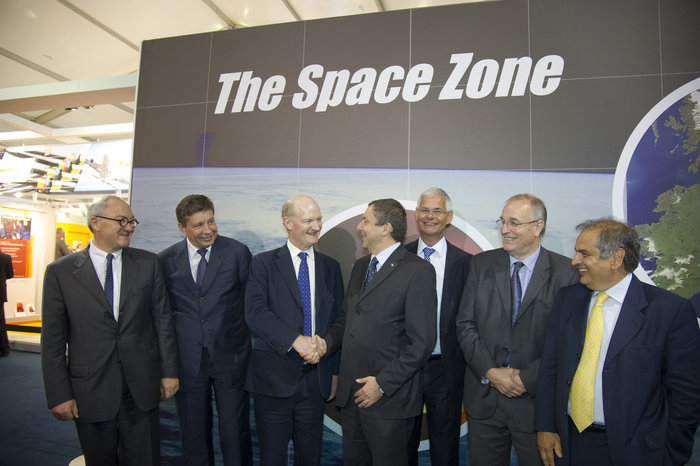
David Willetts and the UK Space Agency hosted a conference of leaders from government, space agencies and the space industry at the Farnborough Air Show, 10 July 2012.
Discussion Period
Fusion Energy and Satellite Clusters in Oxford
The discussion period gave a chance to air frustrations and to trumpet successes. Tokamak Energy pointed out how their fusion energy research bore similarities with the satellite and space cluster in Oxford. The Big Science mentality of the ITER fusion research programme for example resembled Old space, while ‘New fusion’ was represented by companies like Tokamak Energy Ltd, First Light Fusion Ltd, and Applied Fusion Systems Ltd, all in the Oxford area. He noted too that Alan Bond, the inventive force behind Reaction Engines, started his career at the AEA in Culham working on fusion and heat handling.
Catapults
The Satellite Applications Catapult on Harwell pointed out how it is able to draw on a wide range of the technologies represented in the Oxford area, including fusion energy, rocket technology, robotics for hazardous areas, and AI autonomous software: Heat Exchange research for example can find its way into Range Extenders for Electric Vehicles. A representative from the Compound Semiconductor Applications Satellite in South Wales added that Compound Semiconductors are also highly relevant in Space applications.
STFC Daresbury
A representative from IBM which operates the Supercomputer on the STFC Daresbury Campus explained how the group is working on applications using AI. He pointed out how AI could increase the end-to-end value of the whole Space value chain. David Willetts added that the Top 50 Supercomputers were all based outside the UK, but the absence of raw domestic computing power led to the application of smart thinking: he implied it was another ‘hitch hiker’ type of boot strapping.
Financing
One Bessemer member compared the difficulty of raising money in the UK with the USA. He believed the EIS and SEIS could be improved to make hard tech companies less risky for investment. There was a discussion about the absence of institutional funds to support ‘hard tech’ and deep tech. Exceptions mentioned were Legal & General and Aviva. David added that the government’s Patient Capital Review has helped to promote funds that have longer lives than classic VC funds. More should be done however to make investment in hard tech companies attractive for pension funds.
David pointed out how government in the USA absorbs the risk of early stage technology through government departments serving as lead customers. The UK government’s Small Business Research Initiative was launched in 2015 to perform the same function. David added that the Catapults also provided a means of helping early stage companies reduce some of their development risks.
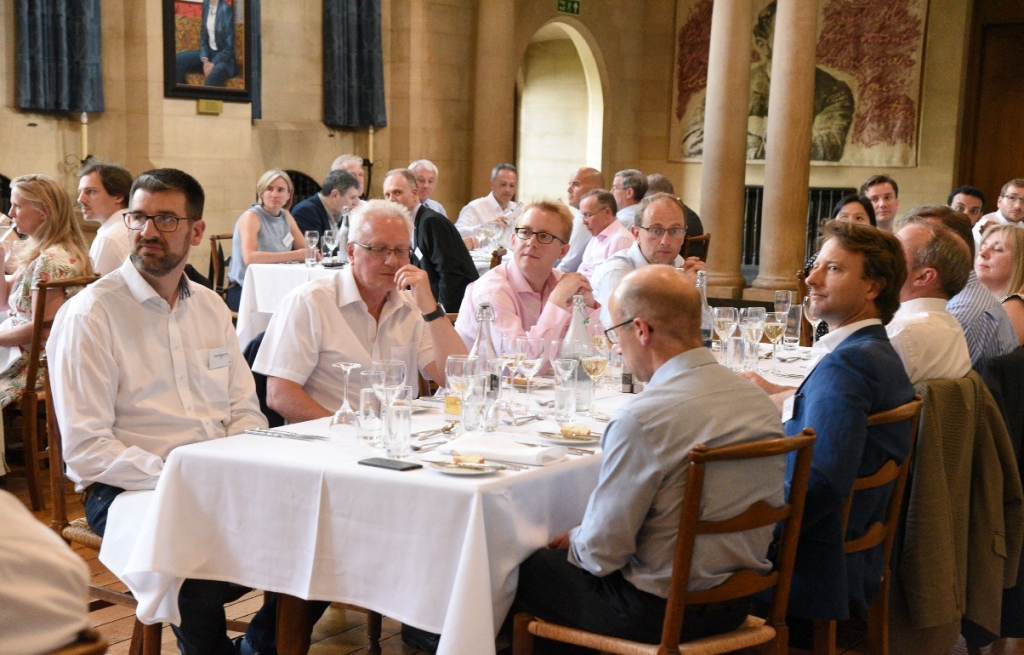
SPONSORSHIP SUPPORTERS
Sincere appreciation to our exclusive Oxford Sponsors: Accountancy Grant Thornton, Law Firm Royds Withy King, Patent Lawyers JA Kemp, and Property Management Bidwells.
Alex Stewart,
September 13th 2018




